The Samsung Galaxy Note5 and Galaxy S6 edge+ Review
by Joshua Ho on October 2, 2015 8:00 AM ESTDisplay
With the rise of smartphones and tablets, the display has become one of the most important aspects of a mobile device as it’s the primary mode of interaction. However, throughout computing the display has generally had relatively little attention. People might have talked about resolution, size, and latency, but the discourse was vague at best. In order to really understand displays, it’s important to discuss a number of factors that affect display quality and the underlying design of the display. These factors range from subpixel arrangement to TFT structure and various emitter materials. With traditional reviewing methods, it’s often difficult to say one way or another whether one display is “better” than another. While simple metrics like maximum brightness can be compared in a relative manner, it’s hard to say whether one has better colors or higher static contrast. In order to test these metrics, we turn to objective measurements from devices like X-Rite’s i1Pro2 spectrophotometer and i1Display Pro colorimeter. In order to acquire the data from these devices and present it in a usable manner, we use SpectraCal’s CalMAN 5 with a custom workflow.
Under the microscope and based upon some quick viewing angle tests, subjectively the Galaxy Note5 display looks and feels like a bigger version of the Galaxy S6 display. Viewing angles for some angles feels like the display is almost painted on to the glass below, but some odd interference effects with viewing angle changes breaks the illusion to some extent. In the case of the S6 edge+, the curved edges of the display cause a noticeable shift in luminance when looking at the edge compared to the center of the display, which also causes an odd green shift which is probably due to the RGBG subpixel layout. I suspect the best LCDs will still be better at the “painted to the glass” illusion for the near future. This isn’t a huge deal, but it is a noticeable difference.
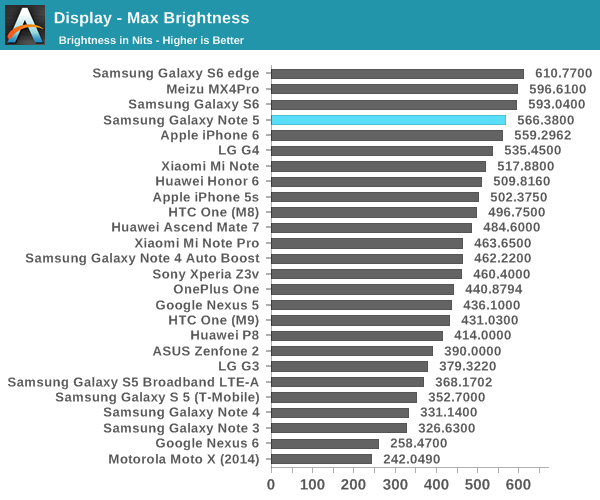
Moving on to our brightness testing, we can see that the Galaxy Note5 delivers a healthy improvement over the Galaxy Note 4 generation of AMOLED, but it isn’t quite at the same level as the Galaxy S6. It isn’t clear why this is the case, but I suspect this is related to longevity and other concerns outside of brightness. Meanwhile the use of OLED means that black levels are perfect and contrast remains solely determined by the lighting of the room and the reflectance of the display, which is similar to most other smartphones.
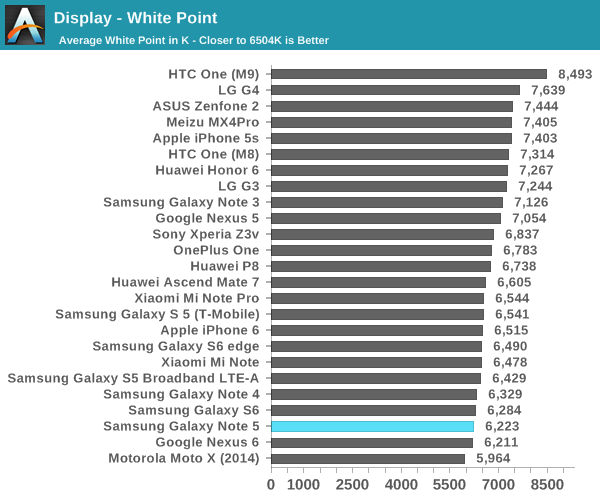
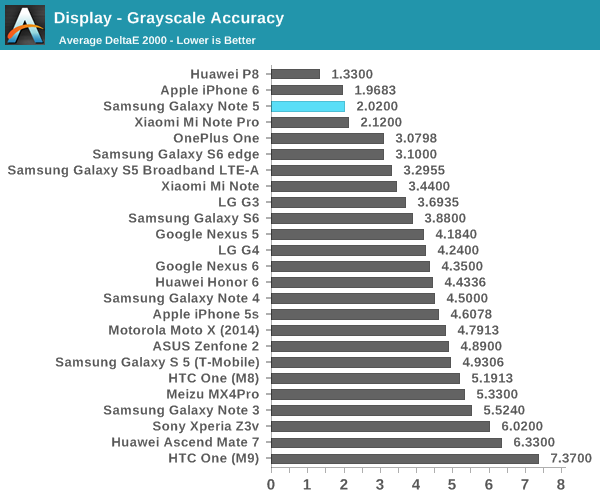
In our standard grayscale testing, the Note5 delivers acceptable color accuracy but it seems that the Basic screen mode tends towards a warm color balance. I suspect this helps with power efficiency, as blue in general requires more power to achieve the same level of luminance. Other than this slightly warm white balance, the grayscale accuracy doesn’t have any significant errors. This means accuracy ends up very good - certainly below our threshold for noticable errors - especially in comparison to the Galaxy Note 4 which had some noticeable problems with green tint on some units.
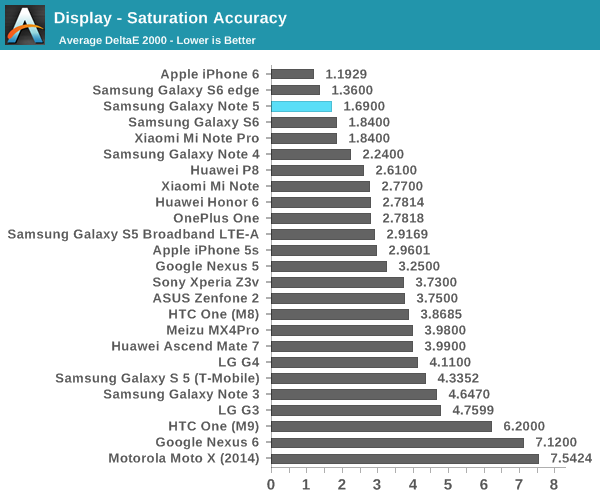
In our saturation test, Samsung does well enough that there’s really nothing to talk about because there's so little wrong here. You could argue that magenta is a bit warm on our review unit, but the difference is too small to be worth talking about. Error on average is going to be hard to spot unless you have a flawless reference monitor to compare against.
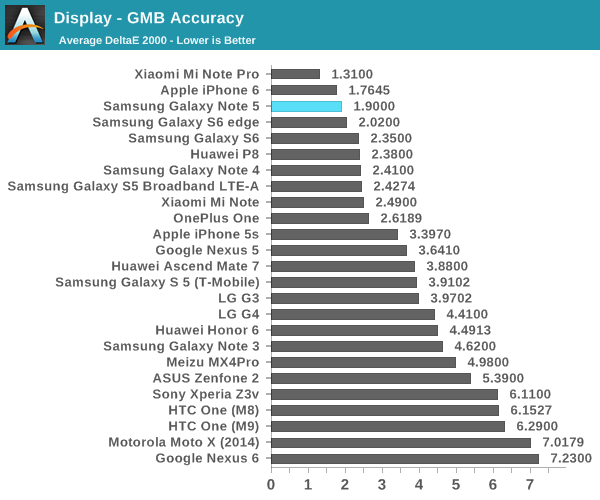
In the GMB ColorChecker test, Samsung continues to show a strong performance when looking at various hues that are commonly found in consumer content such as movies and camera photos. There’s a slight red shift on some of the tested hues, but the error is so minor I don’t notice that any problems here.
Overall, the Galaxy Note5 and Galaxy S6 edge+ both have an incredible display. The Galaxy S6 edge+ does have some problems with viewing angle shifts by virtue of the curved display, but this is effectively unavoidable given the subpixel layout and the radius of curvature. With this generation of AMOLED, Samsung has definitely equaled the best LCDs on the market. I suspect within the next year or two it will be inevitable that Samsung AMOLED will be clearly superior to even the best LCDs. However, without other OLED suppliers that can provide similar quality and cost I suspect OEM adoption will continue to be limited.



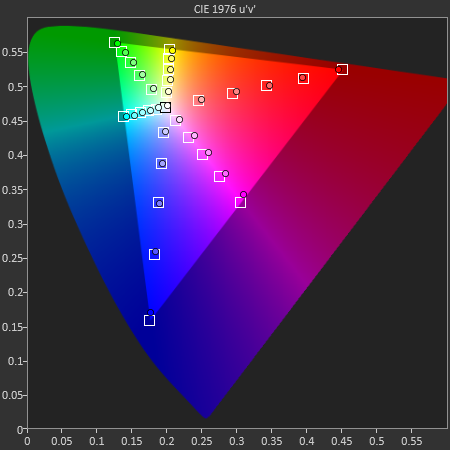
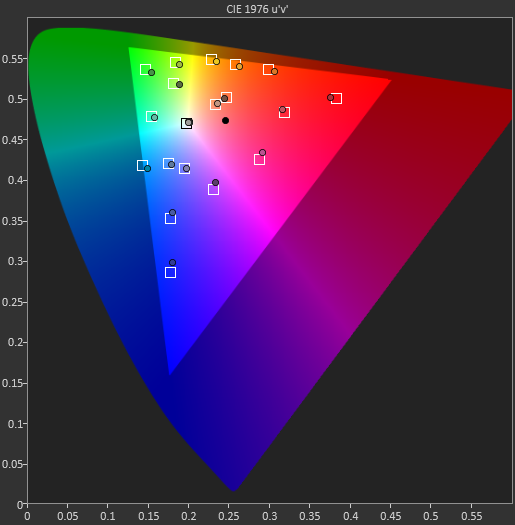








225 Comments
View All Comments
kspirit - Friday, October 2, 2015 - link
Display and battery numbers, etc are on par with the iPhone 6 which is a year old now. The 6S looks like it'll wreck this thing.RMSe17 - Friday, October 2, 2015 - link
Except for the GFX battery, judging by how quickly the 6 ran out.kaidenshi - Sunday, October 4, 2015 - link
Maybe I just don't use my phone enough, but typically at the end of the day I still have around 40-50% battery life on my iPhone 6. My previous device was a Moto G, which was supposedly great with battery life but it would die on me around dinner time even on a light use day.Of course, I'm actually getting work done during the day instead of screwing around on Facebook or Bejeweled clones for 8+ hours at work, so there's that.
LoganPowell - Friday, November 27, 2015 - link
Both phones are good. But between the two, the Galaxy S6 Edge is way better receiving a higher review (see http://www.consumerrunner.com/top-10-best-phones/ for instance...) than S5.farhadd - Monday, October 5, 2015 - link
The reason the iphone 6 runs down fast is because it doesn't throttle the frame rate. It doesn't have to throttle because the metal enclosure can dissipate the heat efficiently enough to keep up.Oyeve - Friday, October 2, 2015 - link
Isnt the display on the 6 and 6s basically the same?close - Friday, October 2, 2015 - link
iPhone 6s has basically the same battery lifetime in real life experience because the battery is a bit smaller. So I really think "wreck" is a way to strong word.tipoo - Friday, October 2, 2015 - link
The 6S has nearly identical display and battery properties (slightly worse) as the 6...?kspirit - Friday, October 2, 2015 - link
It has presumably has a very fast chipset and storage though. Let's see how the camera stacks up to this, as well. I love how they designed the Note 5 but I'm so hesitant to go back to Samsung software after reading all those threads about people running into issues, on reddit :(abrogan - Friday, October 2, 2015 - link
In my family, 2 S4's died quickly after being purchased. My brother has a perfect Note 4, but my neighbor's sister bought an S6. Even after a fresh reformat, it always has the "google play services has stopped responding" error. No way to fix as far as I can tell... it's useless for her, and all the money wasted... My Nexus never has any software bugs, so I'm sticking with Nexus myself. I've had 3 perfect Nexus phones, so I'll buy another Nexus. Not very scientific, but....